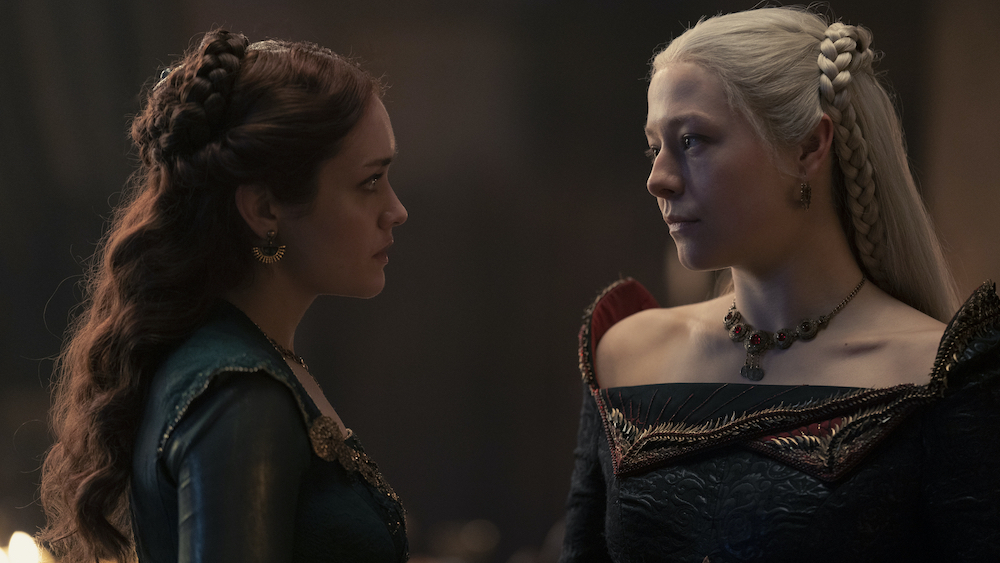“House of the Dragon” has made a name for itself not only as HBO’s wildly popular “Game of Thrones” prequel, but also as a show with a large following that loves to dissect its use of the female gaze, its portrayal of a deeply intimate friendship between young women and that relationship’s subsequent dissolution, and its intense appeal to fans of the romance genre.
For just a glimpse at this group, head over to TikTok, where you’ll find users cutting videos on everything from their preference between Rhaenrya Targaryen (Emma D’Arcy) and her uncle Daemon’s (Matt Smith) romance and her short-lived turn with Ryan Corr’s Harwin Strong, to the complexities of Alicent Hightower’s (Olivia Cooke) ruthless decisions made in the name of her children juxtaposed with her seeming attraction to childhood friend Rhaenyra.
“I can definitely understand that it’s hot watching complex female characters who have agency and who are trying to navigate the world and understand themselves. Like, that is hot,” nonbinary actor D’Arcy says. “And is very different from, I suppose, more two-dimensional portrayals of female sexuality.”

HBO
Cooke adds: “I guess what’s alluring, and quite scintillating, is that they all live in quite close proximity to each other,” noting “House of the Dragon” Season 1’s focus on keeping its characters near the Iron Throne in King’s Landing. “Stealing these loaded looks with someone that you fancy and that’s forbidden, that’s hot. It’s all hot.”
With two women at the center of “House of the Dragon’s” bloody familial war story, author George R.R. Martin and “House of the Dragon” co-creator and showrunner Ryan Condal found it imperative to bring in more female writers and directors than worked on “Game of Thrones” under showrunners David Benioff and Dan Weiss.
“The first story George R.R. Martin published from ‘The Dance of the Dragons’ was an excerpt from ‘Fire & Blood’ called ‘The Princess and the Queen.’ This story was always a female-centric one, so it was important to me to have multiple female voices on the creative team,” Condal says. “Like any great actor, a great writer should be able to put themselves in the shoes of any character and tell their story, but every artist is limited by their own experience — myself included. I know I don’t have all the answers, and I knew that my writing would be improved by the presence of great female storytellers so that we could shape ‘House of the Dragon’ together. I’m incredibly proud of the result: What this team has built together has resonated with audiences and has done so in a way that is complex and nuanced. It is a true feminist story that explores the strengths and shortcomings — warts and all — of the two women at the center of it.” He quips, “We even have female dragons.”
Jokes aside, Geeta Vasant Patel, one of two female directors that “House of the Dragon” had over the course of its first season, says Condal and his Season 1 co-showrunner, Miguel Sapochnik, showed a generous attitude toward the behind-the-scenes team that changed the game for the “Thrones” universe.

HBO
Ollie Upton/HBO
“Someone like me wouldn’t normally direct on ‘Game of Thrones’ in the past,” Patel said. “It’s been a long road for me to get this opportunity and I thank everyone at HBO and Miguel and Ryan for giving me the chance. It’s a great time of celebration for women and people of all different cultures that we are at a place where there is a place for someone like me at the table. Someone like me is trusted with action with politics with adventure with someone’s head being cut off.”
Sara Hess, who wrote the majority of Season 1 alongside Condal, says the goal in all of this “wasn’t specifically focused on women,” but rather to make “every character on our show equally flawed and nuanced and interesting and virtuous and fucked up at the same time and to imbue our women with just as much contradictory flawed humanity as possible.”
“House of the Dragon” is based on Martin’s “Fire & Blood,” a fictional history book about the Targaryen family, which predates the storyline at the center of “Game of Thrones” by almost 200 years.
Over the course of its first season, “House of the Dragon” had four childbirth scenes, some of which were so graphic — including the death-by-childbirth in the premiere — that they disturbed viewers. But Hess found these breaks from what we’re used to seeing on TV vital to the narrative.
“We had a lot of conversation at the beginning about, is this a feature or a flaw?” Hess says. “There’s a lot of births, do we want to see a lot of births? My thinking was, every single childbirth I’ve ever seen on television, in any show, in any genre at any time, has always looked exactly the same: the woman lying on her back with her feet in the stirrups and doing the pushing and the baby comes out. In my experience, women give birth in vastly different ways. I thought we should show them all and they be really, really different, separate experiences and not just, now there’s that birth scene and we all know exactly what it looks like.”

HBO
Following the birth scene in Episode 6, D’Arcy recalls shooting a particularly realistic moment of motherhood when Rhaenyra finally gets to rest after giving birth and immediately going off to show the baby to Alicent: “She gets in and [her sons] Jace and Luc have gone and got a dragon’s egg and want her to look at it. And I just remember responding, ‘Wow, that looks perfect,’ but not looking at them at all, I was looking in the other direction. And that felt like what a lot of parenting is probably like.”
For Cooke, the motherhood mentality hit in Episode 9, written by Hess and directed by Clare Kilner: “That moment in the carriage where Alicent’s hungover son asks her if she loves him, and she says it by smiling and saying, ‘You imbecile.’ Like, it’s so obvious, this is all for you. Everything that I’ve done. Everything that I’ve sacrificed. All the awful things I’ve done in order to facilitate your ascension is because I love the bones of you.”
But motherhood is far from the only aspect of a woman’s life that female writers like Hess and women directors including Kilner and Patel infused into the story, with much of the season focusing on young Alicent (Emily Carey) and Rhaenyra (Milly Alcock) and their deep bond and intense falling out.
“There’s an element of queerness to it,” Hess says. “Whether you see it that way or as just the unbelievably passionate friendships that women have with each other at that age. I think understanding that element of it sort of informs the entire rest of their relationship… Even though they’re driven apart by all these societal, systemic elements and pressures and happenings, at the core of it, they knew each other as children, and they loved each other and that doesn’t go away.”
Hess continued: “Olivia has told me she believes — and this is her headcanon — that they at some point kissed or made out or had some kind of physical interaction that Alicent’s mother found out about and forbade. And that was Olivia’s head story, ‘Oh, I can’t do that. That’s not right.’ And that’s the background for her in their relationship going forward. I would be 100% down with that.”
Cooke says she and D’Arcy have “definitely” talked about Alicent and Rhaenyra being “each other’s first love”: “But when it comes to our iterations of the characters, too much has happened and too much time has passed to probably even recognize those fledgling feelings.”
But Condal and Hess weren’t “necessarily interested in ever defining” what that love meant in terms of the women’s sexuality.
“I happen to be a queer woman, but I know straight women who had ‘Heavenly Creatures’-esque, romantic friendship with their best friend at that age,” Hess said. “That’s something that I think, probably — I don’t want to stereotype anybody – but it seems to be more a phenomenon with young women than it is with men, probably because whether you’re queer or not, society cares less if you’re physically intimate with each other or hugging or touching each other. You can have sleepovers and sleep in the same bed and nobody cares.”

HBO
HBO
Kilner worked with the younger actors in multiple episodes, giving them chances to weigh in on how they think a young woman would act in a particular situation — like when Rhaenyra is scooped up to safety by her admirer Harwin Strong in the middle of a fight during her wedding festivities.
“When we first did it, it was a bit of a classic thing — a man putting a woman over his shoulder and carrying her, and myself and Milly were a bit worried. ‘Ah, what does that mean?’ But then we thought, he is saving her, and she needs to be saved and he’s a strong, big guy!” Kilner says. “And what Milly did, which was beautiful, was sort of kicking and trying to get down at the same time as he was carrying her. I think that struck a good balance in terms of women and agency and not getting too stuck in the old societal norms.”
Many “spicy romance” fans were drawn to this scene on social media, developing a love for Harwin “Breakbones” Strong (aka “Breakmyback,” as he’s known fondly among TikTokers) that existed well beyond his two-episode love arc with Rhaenyra before his untimely death. In contrast to Daemon’s much more chaotic employment of the female gaze, Harwin is an example of the platonic ideal of a heroic partner.
“He’s one of the more unambiguous characters, he’s just a good dude,” Hess said. “You don’t see him off doing morally questionable things, which almost everybody else is doing. They’re so flawed and human and messy. He was able to be a paragon of decency and generosity and handsome strength. He’s one of the guys you could just love and feel great about loving and then he’s ripped from you too soon, before he does anything that could fuck that up for you. He’s our perfect angel.”
The “House of the Dragon” team spent much more time exploring the passion between Smith’s Daemon and D’Arcy’s Rhaenyra. Patel gave the actors the chance to play with how they would authentically act together in a relationship come Episode 8, which marked the first time we had seen the longtime lovers as a married couple in a state of bliss.

HBO
HBO
“When two people have fought so long to be together, there is a sensuality, there is a honeymoon period,” says Patel. “It’s almost sexier than sex, you know, to just love each other so much and to be so excited to be near each other. And then Matt put his hand on her baby bump, and in every take, there was something beautiful. I think that quality of our show, just the realism of relationships, is more sensual than sex.”
“House of the Dragon” doesn’t shy away from the dark aspects of that same relationship, including a scene in the finale where Daemon strangles Rhaenyra. D’Arcy and Smith worked together on how that moment would play out — and how it would affect the way Rhaenyra views Daemon moving forward.
“We were aware we’d need to have a really intimate understanding of what instigates that violence and what it means for them,” D’Arcy said. “What happens in that scene is both parties receive a message from beyond the grave from the lost loved one. When Rhaynera sees that Daemon knows nothing of the prophecy, she finally gets the answer to the question she asked her father throughout the series: Explain the inconsistency of you choosing me to unite the realm, when by doing so, you’ve divided it. She finally gets the answer when she discovers that Daemon was never trusted with the information. Simultaneously, Daemon gets shafted from beyond the grave and he’s a sensitive person who becomes violent when that sensitivity is made visible. Maybe for the first time, it forces Rhaynera to be slightly more practical and pragmatic about the asset that she has in Daemon.”
The earlier days of Rhaenyra and Daemon’s courtship were explored by Kilner in a very personal manner in Episode 4, which featured Alcock’s Rhaenyra going to a brothel and having her first sexual experience with her uncle Daemon — a scene based on Kilner’s own visit to a nightclub in her 20s.

HBO
Ollie Upton/HBO
“I’ve seen how sex scenes would be shot on ‘Game of Thrones’ and I knew I didn’t want to do that,” Kilner said. “The first thing I said to Miguel when I got the brothel scene was, ‘This reminds me of an experience I had when I was about 22 and working as a stage manager in theater and another stage manager — he was gay — took me to a dance club in Berlin. Basically people were having sex left, right and center. And I never forgot that. I remembered the air was thick with sex. Ryan and Miguel really let me run with that. So I was just doing my job, but when I received all of these comments from women and men – but to be honest, mainly women – about how this thing had landed for them, it just made me so happy.”
Specifically, the scenes between two women characters on “House of the Dragon,” including those not shared by Alicent and Rhaenyra, but rather between them and the older Rhaenys Targaryen (Eve Best), are among the cast and creatives’ favorites.
“In those moments, there’s a shared understanding of what it’s like to be women. Even when you’re antagonistic toward each other, we both understand what it’s like to be us. Therefore, we can have conversations that are very different than we would have with a man,” Hess said.
“There’s an embedded empathy when you have a scene with another woman,” Cooke said. “With Alicent and Dyana the servant girl, Alicent being, ‘I know, I know, I know what you feel like. I’ve been that.’ There’s a time when Alicent was having sex with Viserys against her will – martial rape, she’s 14, I don’t know what you’d call it in Westeros – but it’s this umbilical cord of understanding between all these women.”
And in those moments of uniquely female experiences, it helps to have a female writer and director backing you up, which is where Hess and Kilner came in strong for Cooke in Episode 9, which featured a scene where Alicent exposes her feet to allow Larys Strong (Matthew Needham) to masturbate in front of her in exchange for vital information.
“It surprised Olivia and myself how disturbing it was,” Kilner said. “It’s disturbing to see a woman, Alicent, having to humiliate herself to get information and power in a story where men generally don’t have to debase themselves in that way to get information and power. Things happen to women, as we know. So it’s important to dig into it and not pretend it doesn’t exist. But I think every scene, you have to examine and work out what you’re trying to say.”
From Variety US



































